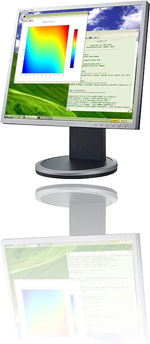EasyChem is a program designed to draw chemical molecules, written under Linux and using Gtk+ 2. Focus is on press-quality final drawings, drawing very easily ornaments (non-bonding electron pairs, …) and exporting to EPS/PDF formats with LaTeX fonts (Computer Modern).
Find EasyChem at: http://easychem.sourceforge.net/
Categories
- Conferences (3)
- education (10)
- Fun (58)
- Meta (12)
- Open Access (10)
- Open Data (13)
- open science (34)
- Policy (48)
- Science (135)
- Software (633)
- Acoustics (3)
- Engineering (1)
- Physical (1)
- Speech Communication (2)
- Structural (1)
- Anthropology and Archaeology (3)
- Artificial Life (9)
- Astronomy (21)
- Aviation and Aeronautics (2)
- Chemistry (131)
- Analytical (4)
- Atmospheric (1)
- Biochemistry (6)
- Biophysical (3)
- Chemical Information (3)
- Crystallography (2)
- Electrochemistry (1)
- Molecule Viewers and Editors (39)
- Organic (2)
- Synthesis (1)
- Periodic Tables (3)
- Physical (1)
- Kinetics (1)
- Polymers (1)
- Spectroscopy (9)
- NMR (5)
- Surfaces (1)
- Theoretical and Computational (45)
- Cognitive Science (3)
- Neural Networks (2)
- Complex Systems (2)
- Computer Science (22)
- Algorithms And Computational Theory (2)
- Artificial Intelligence (4)
- Data Communication (4)
- Information Retrieval (1)
- Knowledge Discovery and Data Mining (3)
- Languages (1)
- Fortran (1)
- Measurement and Evaluation (1)
- Simulation and Modeling (2)
- Software Engineering (2)
- Symbolic and Algebraic Manipulation (1)
- Earth Sciences (19)
- Geology and Geophysics (5)
- Hydrology (5)
- Meteorology (1)
- Oceanography (3)
- Energy (3)
- Engineering (24)
- Forensics (2)
- Geography (12)
- Information Technology (1)
- Life Sciences (60)
- Bioinformatics (34)
- Ecology (5)
- Evolution and Population Genetics (3)
- Statistical (1)
- Theoretical (1)
- Genetics (9)
- Population (1)
- Medical Sciences (7)
- Physiology (2)
- Linguistics (2)
- Mathematics (108)
- Abstract Algebra (9)
- Combinatorics (1)
- Differential Equations (17)
- Fluid Dynamics (7)
- Ordinary (3)
- Partial (7)
- Dynamical Systems (4)
- Education (1)
- Geometry (3)
- Linear Algebra (26)
- Number Theory (6)
- Numerical Methods (5)
- Optimization (12)
- Probability (1)
- Set Theory (1)
- Statistics (8)
- Topology (1)
- Measurements and Units (3)
- Nanotechnology (2)
- Physics (30)
- Astrophysics (1)
- Atomic and Molecular (1)
- Computational (2)
- Condensed Matter (4)
- Dynamics (2)
- Fluid (1)
- High Energy (4)
- Magnetism (1)
- Materials (1)
- Nuclear (4)
- Optics (5)
- Plasma (1)
- Required Reading and Other Sites (25)
- Space (3)
- Tools (56)
- Numerical Libraries (8)
- Random Number Generators (2)
- Visualization (18)
- 2D Plotting (8)
- 3D Plotting (2)
- Acoustics (3)
- Uncategorized (4)

 My new iPhone is just about the most amazing piece of technology I’ve ever used. There’s just one problem: I hate hate hate the calculator. Apple’s normal desktop calculator on OS X is remarkably functional. It has the standard scientific functions, a programmer’s mode, and best of all, there’s an RPN mode, which is essential for those of us who grew up with HP scientific calculators and therefore can’t figure why one would even want to use a “normal” calculator.
My new iPhone is just about the most amazing piece of technology I’ve ever used. There’s just one problem: I hate hate hate the calculator. Apple’s normal desktop calculator on OS X is remarkably functional. It has the standard scientific functions, a programmer’s mode, and best of all, there’s an RPN mode, which is essential for those of us who grew up with HP scientific calculators and therefore can’t figure why one would even want to use a “normal” calculator. A whole bunch of new software to highlight today:
A whole bunch of new software to highlight today: